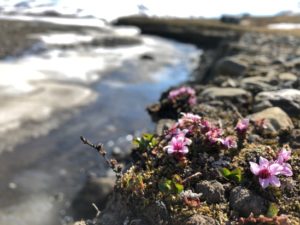 Has autopolyploidisation(s) (diploid to tetraploid in particular) created a shift in reproductive parameters?
Has autopolyploidisation(s) (diploid to tetraploid in particular) created a shift in reproductive parameters?
Project description:
In this project I aim to investigate consequences of autopolyploidy on phenotypic variation, with focus on reproductive strategy and reproductive output. I will use the circumpolar, arctic-alpine plant species Saxifraga oppositifolia (Saxifragaceae), where two main ploidy levels are known (diploids and tetraploids). Saxifraga oppositifolia thrives in a wide range of habitats; from early snow free, extremely dry ridges with long growing season, to moist snow beds with short growing season. It also shows different growth forms, which are partly connected to ploidy levels and habitat. Differences in flower production and vegetative growth differ clearly between habitats and growth forms, but how reproduction is varying between cytotypes is not known. I will use five already established transects located in different valleys close to Longyearbyen. The transects cover three different habitats where S. oppositifolia is growing (river, slope, ridge). I will collect data related to both sexual and vegetative reproduction within different cytotypes and habitats to address the following main question: Has autopolyploidisation(s) (diploid to tetraploid in particular) created a shift in reproductive parameters?
Tasks:
Students will:
– collect data on number of flowers, capsules and seeds in field
– sample trailling braches of different plants with different ploidy levels in the field and test rooting ability in the climate chamber
– collect pollen from bursted anthers in field
Work tasks will vary depending on when students are joining in.
Students have to enjoy being out in the field and cope with long days without freezing. The project work require the ability to work preciously and pay attention to small details.
The project involves:
Field work and work in the climate chamber at UNIS
Starting date/period:
1 July – 30 Sept 2020
Experience/skills to be acquired:
The student will learn different sampling methods to measure reproduction of both sexual and vegetative investment. Furthermore, the student will learn how to use the obtained data in germination- and rooting ability tests under different controlled conditions in the UNIS climate chamber. Students will also learn how to sample pollen and how this can tell us something about the production of unreduced gametes. Experiences obtained from this project will be vey useful in future fieldwork and in any type of controlled growth experiments with plants.
Involvement:
Flexible (max 40h). It is recommended to work at least 7 h/day when being in the field.
Interested by this project? Need more info? Contact:
Ingrid Vesterdal Tjessem
ingridvt@student.matnat.uio.no
Project number: 9
